Tomás Teijeiro
Mathematical model of parameters relevance in adaptive level-crossing sampling for electrocardiogram signals
Jan 18, 2025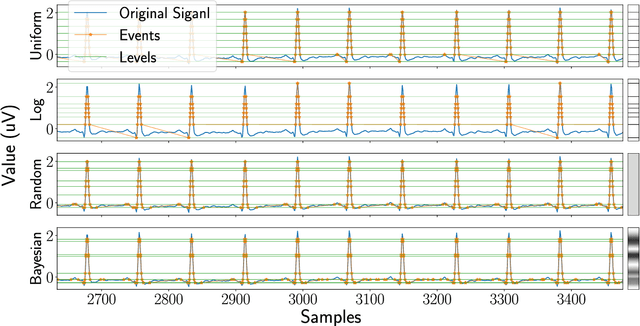
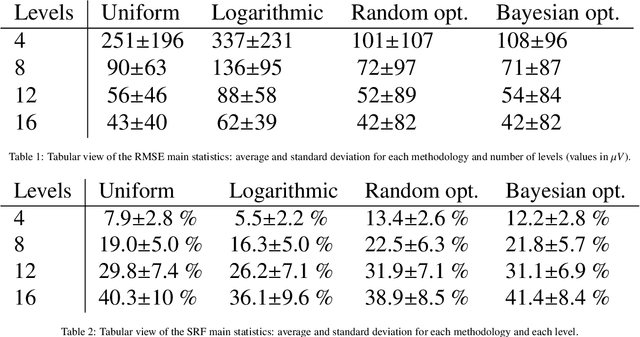
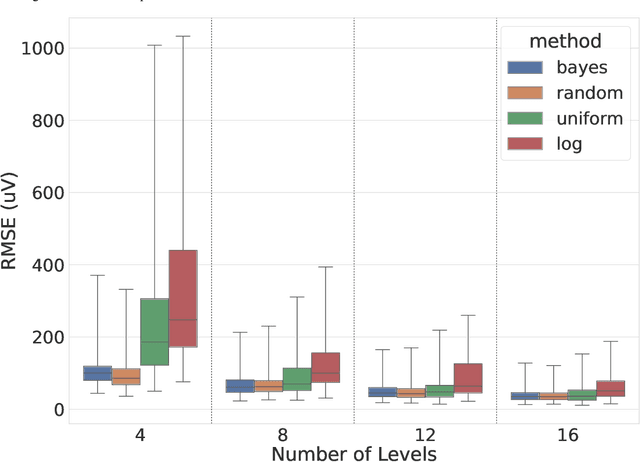

Abstract:Digital acquisition of bio-signals has been mostly dominated by uniform time sampling following the Nyquist theorem. However, in recent years, new approaches have emerged, focused on sampling a signal only when certain events happen. Currently, the most prominent of these approaches is Level Crossing (LC) sampling. Conventional level crossing analog-to-digital converters (LC-ADC) are often designed to make use of statically defined and uniformly spaced levels. However, a different positioning of the levels, optimized for bio-signals monitoring, can potentially lead to better performing solutions. In this work, we compare multiple LC-level definitions, including statically defined (uniform and logarithmic) configurations and optimization-driven designs (randomized and Bayesian optimization), assessing their ability to maintain signal fidelity while minimizing the sampling rate. In this paper, we analyze the performance of these different methodologies, which is evaluated using the root mean square error (RMSE), the sampling reduction factor (SRF) -- a metric evaluating the sampling compression ratio -- , and error per event metrics to gauge the trade-offs between signal fidelity and data compression. Our findings reveal that optimization-driven LC-sampling, particularly those using Bayesian methods, achieve a lower RMSE without substantially impacting the error per event compared to static configurations, but at the cost of an increase in the sampling rate.
An Error-Based Approximation Sensing Circuit for Event-Triggered, Low Power Wearable Sensors
Jun 25, 2021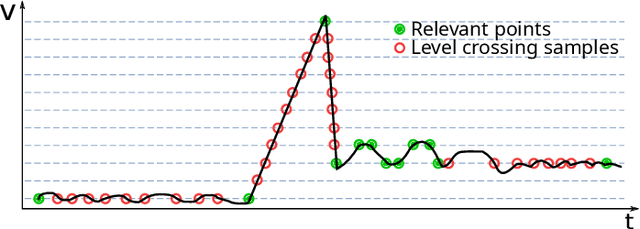
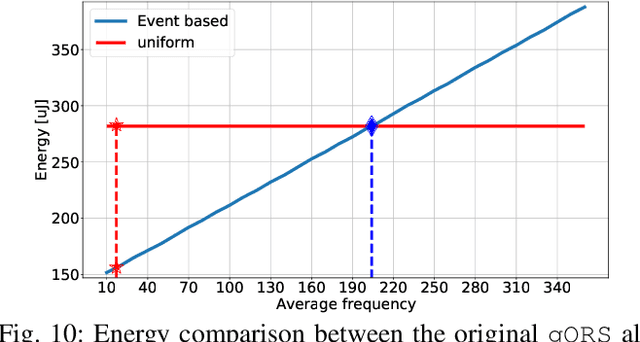
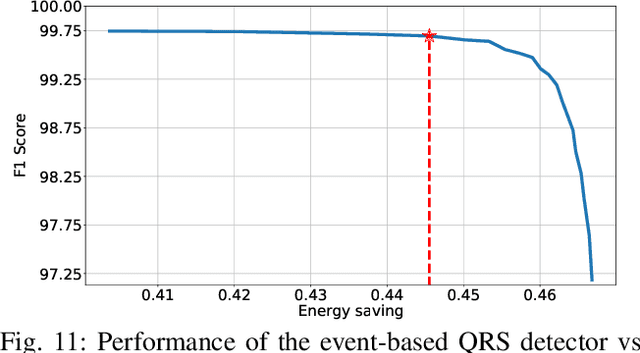
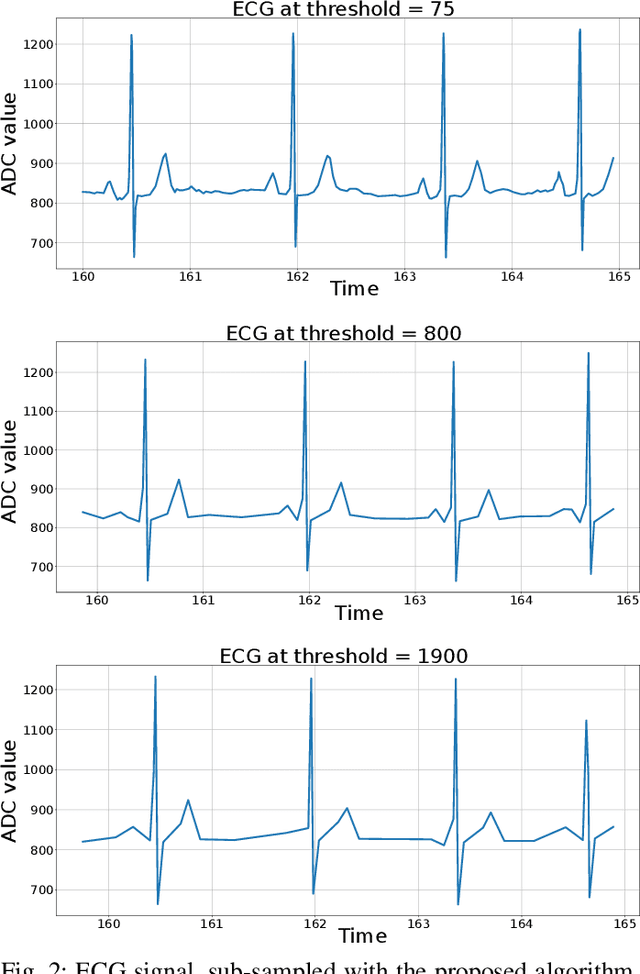
Abstract:Event-based sensors have the potential to optimize energy consumption at every stage in the signal processing pipeline, including data acquisition, transmission, processing and storage. However, almost all state-of-the-art systems are still built upon the classical Nyquist-based periodic signal acquisition. In this work, we design and validate the Polygonal Approximation Sampler (PAS), a novel circuit to implement a general-purpose event-based sampler using a polygonal approximation algorithm as the underlying sampling trigger. The circuit can be dynamically reconfigured to produce a coarse or a detailed reconstruction of the analog input, by adjusting the error threshold of the approximation. The proposed circuit is designed at the Register Transfer Level and processes each input sample received from the ADC in a single clock cycle. The PAS has been tested with three different types of archetypal signals captured by wearable devices (electrocardiogram, accelerometer and respiration data) and compared with a standard periodic ADC. These tests show that single-channel signals, with slow variations and constant segments (like the used single-lead ECG and the respiration signals) take great advantage from the used sampling technique, reducing the amount of data used up to 99% without significant performance degradation. At the same time, multi-channel signals (like the six-dimensional accelerometer signal) can still benefit from the designed circuit, achieving a reduction factor up to 80% with minor performance degradation. These results open the door to new types of wearable sensors with reduced size and higher battery lifetime.
On the adoption of abductive reasoning for time series interpretation
Jun 25, 2018



Abstract:Time series interpretation aims to provide an explanation of what is observed in terms of its underlying processes. The present work is based on the assumption that the common classification-based approaches to time series interpretation suffer from a set of inherent weaknesses, whose ultimate cause lies in the monotonic nature of the deductive reasoning paradigm. In this document we propose a new approach to this problem, based on the initial hypothesis that abductive reasoning properly accounts for the human ability to identify and characterize the patterns appearing in a time series. The result of this interpretation is a set of conjectures in the form of observations, organized into an abstraction hierarchy and explaining what has been observed. A knowledge-based framework and a set of algorithms for the interpretation task are provided, implementing a hypothesize-and-test cycle guided by an attentional mechanism. As a representative application domain, interpretation of the electrocardiogram allows us to highlight the strengths of the proposed approach in comparison with traditional classification-based approaches.
* 44 pages, 9 figures
Abductive reasoning as the basis to reproduce expert criteria in ECG Atrial Fibrillation identification
Feb 16, 2018
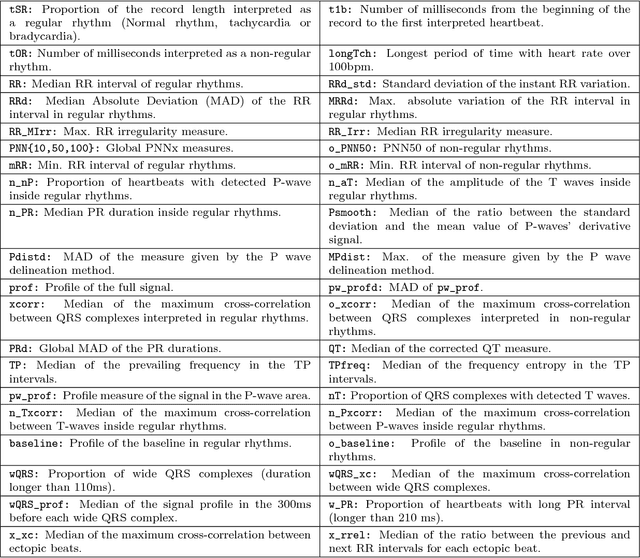


Abstract:Objective: This work aims at providing a new method for the automatic detection of atrial fibrillation, other arrhythmia and noise on short single lead ECG signals, emphasizing the importance of the interpretability of the classification results. Approach: A morphological and rhythm description of the cardiac behavior is obtained by a knowledge-based interpretation of the signal using the \textit{Construe} abductive framework. Then, a set of meaningful features are extracted for each individual heartbeat and as a summary of the full record. The feature distributions were used to elucidate the expert criteria underlying the labeling of the 2017 Physionet/CinC Challenge dataset, enabling a manual partial relabeling to improve the consistency of the classification rules. Finally, state-of-the-art machine learning methods are combined to provide an answer on the basis of the feature values. Main results: The proposal tied for the first place in the official stage of the Challenge, with a combined $F_1$ score of 0.83, and was even improved in the follow-up stage to 0.85 with a significant simplification of the model. Significance: This approach demonstrates the potential of \textit{Construe} to provide robust and valuable descriptions of temporal data even with significant amounts of noise and artifacts. Also, we discuss the importance of a consistent classification criteria in manually labeled training datasets, and the fundamental advantages of knowledge-based approaches to formalize and validate that criteria.
Arrhythmia Classification from the Abductive Interpretation of Short Single-Lead ECG Records
Nov 10, 2017



Abstract:In this work we propose a new method for the rhythm classification of short single-lead ECG records, using a set of high-level and clinically meaningful features provided by the abductive interpretation of the records. These features include morphological and rhythm-related features that are used to build two classifiers: one that evaluates the record globally, using aggregated values for each feature; and another one that evaluates the record as a sequence, using a Recurrent Neural Network fed with the individual features for each detected heartbeat. The two classifiers are finally combined using the stacking technique, providing an answer by means of four target classes: Normal sinus rhythm, Atrial fibrillation, Other anomaly, and Noisy. The approach has been validated against the 2017 Physionet/CinC Challenge dataset, obtaining a final score of 0.83 and ranking first in the competition.
Using temporal abduction for biosignal interpretation: A case study on QRS detection
Feb 05, 2015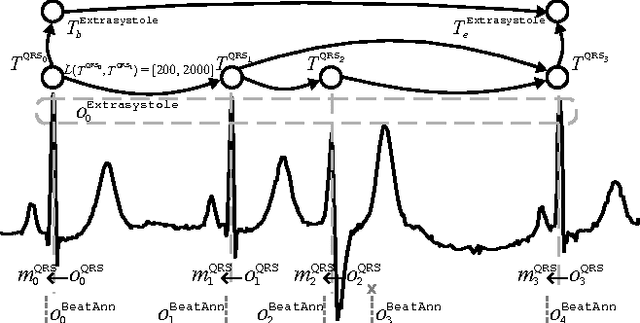
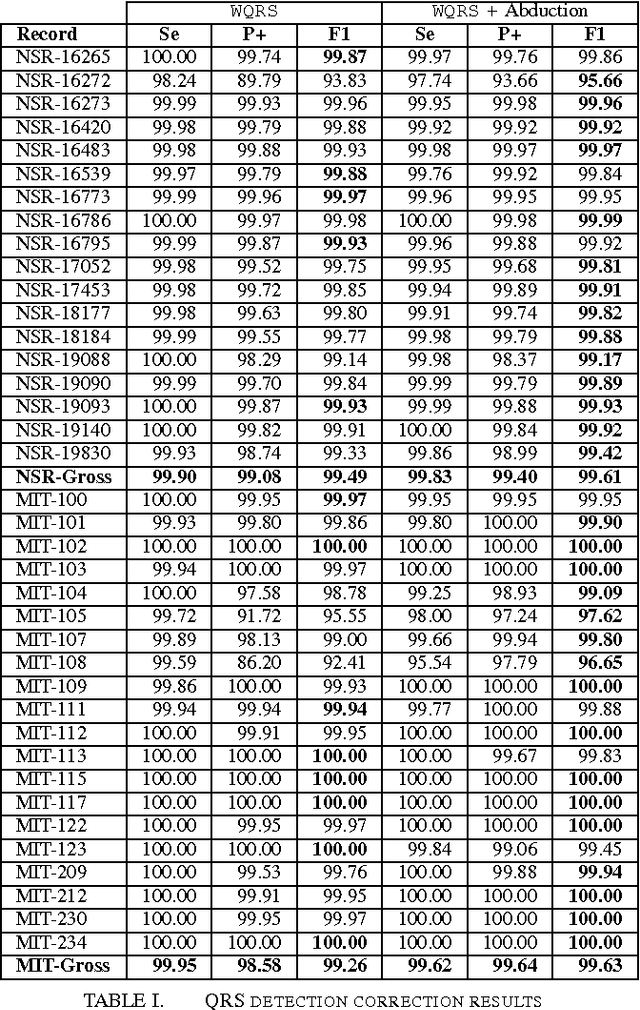
Abstract:In this work, we propose an abductive framework for biosignal interpretation, based on the concept of Temporal Abstraction Patterns. A temporal abstraction pattern defines an abstraction relation between an observation hypothesis and a set of observations constituting its evidence support. New observations are generated abductively from any subset of the evidence of a pattern, building an abstraction hierarchy of observations in which higher levels contain those observations with greater interpretative value of the physiological processes underlying a given signal. Non-monotonic reasoning techniques have been applied to this model in order to find the best interpretation of a set of initial observations, permitting even to correct these observations by removing, adding or modifying them in order to make them consistent with the available domain knowledge. Some preliminary experiments have been conducted to apply this framework to a well known and bounded problem: the QRS detection on ECG signals. The objective is not to provide a new better QRS detector, but to test the validity of an abductive paradigm. These experiments show that a knowledge base comprising just a few very simple rhythm abstraction patterns can enhance the results of a state of the art algorithm by significantly improving its detection F1-score, besides proving the ability of the abductive framework to correct both sensitivity and specificity failures.
 Add to Chrome
Add to Chrome Add to Firefox
Add to Firefox Add to Edge
Add to Edge